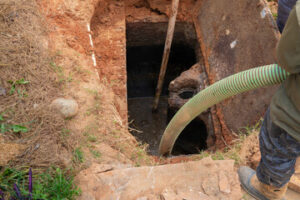Termites are destructive wood-eating pests often found in homes. They eat the cellulose in wood and plant material and can cause extensive damage.
A common treatment method involves soil-applied termiticides such as Termidor or Premise. These are effective and long-lasting barriers to termite entry. Read and follow all label instructions carefully to ensure safe use. Contact Termite Control Gilbert AZ now!

The best way to prevent a termite infestation is to keep the pests out in the first place. Regular inspections and prevention techniques, such as soil treatments, wood treatment, and bait systems, are the most effective ways to protect your home from these destructive pests.
The most common way to protect against a termite infestation is by eliminating conducive conditions around your home, such as allowing water to flow away from your house, keeping landscaping vegetation far away from outside walls, and directing irrigation away from the foundation. Other methods include avoiding wood-to-ground contact when building, using treated wood if necessary in an area that is moist or near the ground, and eliminating cellulose materials (such as firewood and mulch) close to exterior wall coverings.
A swarm of winged termites is the most telltale sign of an impending infestation, although it is important to note that termites may also attack houses without swarming. Other indicators of a potential problem are small pellets of droppings called frass that may be seen on the floor or under wallpaper. Damage to woodwork inside a home, such as a hollow sound when tapping on walls or floors, and mud tubes running up the side of the house can also indicate an active termite infestation.
While a popular myth states that Formosan subterranean termites have a structure on their heads that shoots rock-dissolving acid, these pests actually secrete a type of latex which helps them devour timber. A skilled professional can determine the most appropriate preventive termite control method based on your property, construction, and neighborhood, including a soil-applied barrier treatment or direct wood treatment.
A barrier treatment involves spraying a termiticide onto the surface of wood members and into any cracks, crevices, or voids in which you suspect the pests might be living. These chemicals, such as Termidor and Premise, penetrate the surface of wood to create a protective layer that resists termite penetration. Another method involves injecting a direct wood treatment, such as foam termiticide, into wood members and into wall voids. This odorless material expands to fill the space, killing the termites that touch it.
Treatment
A variety of treatments are available to help protect structures from the damage caused by termites. Often, it’s less expensive to prevent an infestation than to eradicate one and repair the damage. A reputable pest control company can offer advice and recommendations on preventing future infestations.
Pretreating wood is one of the most effective ways to protect a home or business from termite damage. Pretreating wood is performed by injecting it with a chemical that acts as a barrier against termites. Most pest control companies are equipped to perform this treatment and can guarantee the effectiveness of their work. Chemicals used for pretreating include wood destroying organism (WDO) preservatives and liquid termiticides. The latter is injected into the soil around a structure and provides long lasting protection, typically for about five years.
If you are planning to build a new home or are buying an existing house, ask your termite inspection company about pretreating the wood. This can be done during construction, and the process is generally a lot less invasive than cutting into walls to treat them later. It’s also much cheaper than treating an established home for termites.
Wood treated with boron is another long-lasting way to prevent termite infestations. When absorbed by wood, it changes the cell structure of the insect and renders it ineffective at digesting cellulose. The boron must be replenished periodically to maintain its protective effect.
Chemical treatments for current termite infestations include surface applications of liquid termiticide poured directly onto infested wood and the injection of slow-acting insecticide into wood components and in the soil surrounding them. The latter method can be more precise, allowing the pesticide to target specific areas of the colony and eliminating it.
Infestation is most likely in places where wood contact with the ground is limited, such as in crawl spaces, basements and utility and sewer pipe openings. In these situations, the termites move from the soil to the interior of the house, using mud-like shelter tubes to bridge the gap. The presence of these tubes on foundation walls, along with a musty odor and pin-sized holes in drywall, are indicators of a termite problem.
Inspection
A termite inspection is the first step to controlling a potential infestation. A qualified inspector focuses on conditions that attract and support these wood-destroying pests. They look for mud tubes, wood damage and droppings (also called frass) that appear as small granular oval pellets on door frames, baseboards and window sills. Inspectors also assess the crawl space under a home and any wood structures on the property. They also check the foundation of a home and look for signs of moisture problems such as swollen floors or cracking in walls.
A trained inspector can also identify a number of other wood-destroying insects such as carpenter ants, beetles and woodpeckers that might have damaged a home. In addition, they can detect structural issues such as loose floor joists and chimney foundation damage.
During a termite inspection, a professional can help to reduce the risk of future termite infestations by providing preventative treatment options. This may include installing barriers to stop ground-to-ground contact such as concrete or metal, ensuring wooden fences and garden structures are raised above the soil and using termite-resistant materials when building or renovating. Other preventative measures include making sure downspouts drain away from a home, keeping wood mulch at least six to twelve inches away from a home and ensuring steps and posts are supported by concrete rather than rotted or decaying wood.
When termites are treated promptly, the likelihood of a full infestation is significantly reduced. A termite control plan can usually be implemented within a few days of an inspection, eliminating the pests and preventing re-infestation.
A typical termite control procedure includes trenching around a home, then drilling into the affected area to remove the termites and their eggs. Then, a chemical is applied to the soil around a house to keep the termites from returning. Follow-up treatments may be required to continue to deter recurrence of the infestation, or to address any new areas of activity.
Regular inspections and addressing conducive conditions can help to reduce the risk of future termite problems. In addition to scheduling regular termite inspections, homeowners can take preventative measures such as reducing moisture levels by repairing leaky pipes and dripping roof tiles, keeping down branches overhanging the home, ensuring downspouts are properly directing water away from the foundation, and avoiding direct contact between wood and soil with barrier products such as concrete or metal.
Maintenance
Termite infestations can be prevented by using a variety of techniques. The most effective is to work with a professional pest control company that specializes in termite treatment and inspections. Regular inspections should be done to keep on top of potential issues and address them as quickly as possible to minimize the damage and prevent costly repairs.
During a regular inspection, an experienced inspector will look for signs of termite activity in and around your home or business. The inspector will also assess the condition of wooden structures on your property such as fences, garden sheds and more. He or she will also be able to identify the type of termites that are present in your yard by looking for mud tubes, discarded wings and rotting wood.
If a termite problem is spotted, the inspector will recommend the best course of action to treat the infestation. Depending on the situation, this may include a soil treatment to kill the termites that are infesting your property. For a more targeted approach, a termiticide can be injected into the wood to more closely target a specific area of an existing infestation.
It is important to follow proper safety guidelines and precautions when working with termite treatments and chemicals to minimize exposure risks to yourself and others in the house. For example, you should ensure that all doors and windows are closed during a termite treatment. In addition, it is vital to reduce moisture levels by ensuring that crawl spaces are properly ventilated and leaks are promptly repaired.
Natural and eco-friendly methods to treat and protect against termites are becoming increasingly popular. These can involve the use of beneficial nematodes and fungal pathogens that are applied to the soil in an effort to parasitize or infect the termites. Orange oil treatments can also be used to deliver a low-risk and targeted treatment that is specifically targeted at a particular area of an existing termite infestation. The costs associated with these alternative options can vary widely depending on the size and scope of the termite infestation to be addressed.





